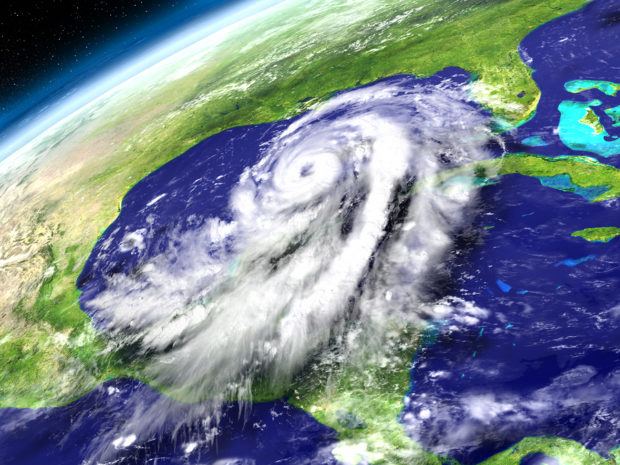Millions of people in the U.S. southeast were ordered to flee as Hurricane Matthew, set to become the strongest storm to hit the country since 2005, headed toward Florida’s East Coast after leaving hundreds dead in Haiti.
The storm was downgraded Friday to Category 3, with winds of 120 miles (195 kilometers) an hour. It is expected to move near or over the east coast of the Florida peninsula through Friday evening and then track along the Atlantic coast, racking up as much as $50 billion in economic losses. At least 2 million people have been ordered to flee its path, with evacuations under way in Georgia and South Carolina. In one part of Haiti’s southwest region, 283 people have died and authorities expect the nationwide death toll to rise, The Associated Press reported.
(Related Story: The P/C Insurance Industry and Analysts Scramble for Hurricane Matthew)
Across the U.S., more than 3,200 flights have been canceled, most originating from Florida, according to FlightAware, a Houston-based airline tracking company. Matthew has shut the Buckeye oil terminal in Freeport, Bahamas, and could disrupt petroleum shipments along the U.S. East Coast.
The U.S. hasn’t been hit by a major hurricane with winds of 111 miles per hour or more since Wilma struck Florida in October 2005. Katrina, also in 2005, caused about $154 billion in damage, adjusted for inflation, making it the costliest in U.S. history, according to the National Oceanic and Atmospheric Administration. Matthew has already devastated the Caribbean.
“They have never had a major hurricane hit from Cape Canaveral northward to Georgia in the past century,” said Jeff Masters, co-founder of Weather Underground, in Ann Arbor, Michigan. He described Matthew as “the most dangerous for Florida since Wilma.”
Life-Threatening Winds
Matthew was about 40 miles east southeast of Cape Canaveral, the U.S. National Hurricane Center said in an advisory at 5 a.m. New York time Friday. People caught without shelter in the hardest-hit areas face life-threatening winds, damage to buildings, roads and bridges, and the loss of power and communications that could render places uninhabitable for weeks or months, the National Weather Service said. The storm surge could reach 11 feet in some places.
NextEra Energy Inc.’s Florida Power & Light utility, the state’s largest, said as many as 2.5 million customers could lose power, some for extended periods. FPL may need 11 days to two weeks to restore 90 percent of blacked out homes and businesses, said Matthew Cordaro, a trustee of the Long Island Power Authority and the former chief executive officer of the U.S. Midwest’s power grid operator.
Florida Governor Rick Scott said Thursday that the state would have at least six days’ worth of fuel supplies if all ports close and that individual retailers experiencing temporary fuel shortages were being “quickly refueled.”
Matthew could “easily take out” half of Florida’s grapefruit production if it stays on its current track, said Thomas Spreen, industry consultant and retired agricultural economist at the University of Florida.
“FPL is anticipating a significant and challenging restoration effort along parts of Florida’s east coast,” the utility said in a statement. “FPL may have to rebuild parts of its electric system.”
Depending on Matthew’s track and strength, damages could reach $50 billion, according to Chuck Watson, a disaster modeler with Enki Research in Savannah, Georgia. Bloomberg Intelligence analysts Jonathan Adams and Jeffrey Flynn, citing Kinetic Analysis data, predict $35 billion in economic losses.
Matthew has more than $1 trillion in property in its path, and there’s a 25 percent chance of it causing more than $50 billion in damage, Watson said.
Economic Losses
“I think Matthew is destined for the top ten” costliest storms, he said.
At least 954,394 homes, with a value of about $189 billion, are at risk from storm surge, according to CoreLogic Inc., a property analysis consultant.
Twelve U.S. power generators, including two nuclear plants, are in the storm’s path, according to data compiled by Bloomberg. NextEra said it shut its St. Lucie reactor in Florida in anticipation of high winds.
Walt Disney Co. was closing its Orlando theme parks and said they would remain shut Friday. Comcast Corp.’s Universal Studios also planned to shutter. Cruise lines rerouted at least 19 voyages, canceling stops and in some cases completely avoiding the Caribbean, according to the website CruiseCritic.com.
The worst case for damage would be if Matthew’s eye, with the strongest winds and highest storm surge, tracked along a large stretch of Florida’s coastline, said Masters. There is also a chance Matthew could wobble, leaving the worst of the storm out at sea, he said.
Eye Wall
“Any slight deviation to the east or west could conceivably mean several billion dollars of damage,” Steve Bowen, a director and meteorologist with Aon Benfield in Chicago, said by telephone.
Matthew is set expected to weaken in the next 48 hours but is forecast to remain a category 3 hurricane as it approaches the coast of Florida, the National Hurricane Center said.
Updates with flight and oil disruptions in third paragraph.
–With assistance from Mary Schlangenstein, Sheela Tobben, Jim Polson, Christopher Palmeri, Marvin G. Perez, Laura Blewitt and Angelina Rascouet.





















 Florida Gets 8 New P/C Carriers After Insurance Market Reforms
Florida Gets 8 New P/C Carriers After Insurance Market Reforms  La Nina 60% Likely to Develop Between June-August
La Nina 60% Likely to Develop Between June-August  USAA to Lay Off 220 Employees
USAA to Lay Off 220 Employees  AM Best Downgrades State Farm General Ratings
AM Best Downgrades State Farm General Ratings 





